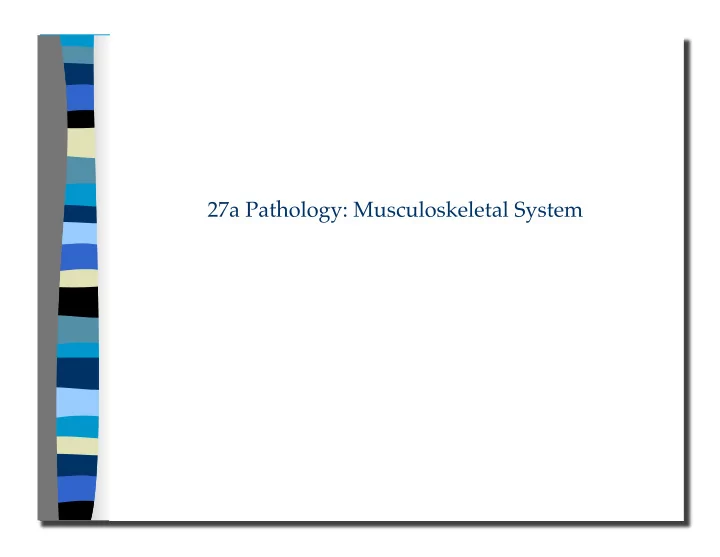

27a Pathology: Musculoskeletal System
27a Pathology: Musculoskeletal System � Class Outline � 5 minutes � � Attendance, Breath of Arrival, and Reminders � 10 minutes � Lecture: � 25 minutes � Lecture: � 15 minutes � Active study skills: � 60 minutes � Total �
27a Pathology: Musculoskeletal System � Class Reminders � Quizzes: � 29b Kinesiology Quiz � � – Supraspinatus, infraspinatus, teres major, subscapularis, pec minor, & serratus anterior � 31a Written Exam Prep Quiz (20a, 20b, 21b, 22a, 23a, 24b, 29b, and 30a) � � 32a Written Exam Prep Quiz (24a, 25a, 26a, 27a, 28a, 29a, 30b, and 31b) � � Assignments: � 30a Review Questions � � – Packet A: 123-140 � Preparation for upcoming classes: � 28a A&P: Integumentary System � � – Trail Guide: serratus anterior � – Salvo: Chapter 22 � – Packet E: 53-56 � – Packet A: 135-136 � 28b Integration Massage: Swedish and Hydrotherapy � � – Packet F: 63-64 �
Classroom Rules � Punctuality - everybody’s time is precious � Be ready to learn at the start of class; we’ll have you out of here on time � � Tardiness: arriving late, returning late after breaks, leaving during class, leaving � early � The following are not allowed: � Bare feet � � Side talking � � Lying down � � Inappropriate clothing � � Food or drink except water � � Phones that are visible in the classroom, bathrooms, or internship � � You will receive one verbal warning, then you’ll have to leave the room. �
27a Pathology: Musculoskeletal System � E-47
Muscle Disorders � � Muscular dystrophy � � Spasms and Cramps � � Fasciculations � � Strains �
Muscle Disorders � Muscular dystrophy Group of several closely related diseases characterized by genetic anomalies that lead to the degeneration and wasting away of muscle tissue. �
Muscle Disorders � Spasms Low-grade and long-lasting involuntary contraction of skeletal muscles or muscle groups. � Cramps (AKA: charley horse) Strong, painful, and usually short-lived involuntary contractions of skeletal muscles or muscle groups. �
Muscle Disorders � Fasciculations (AKA: twitching) Painless momentary contraction of a small number of superficial muscle fibers. �
Muscle Disorders � Strains Injuries to muscle fibers involving the tearing of muscle fibers and production of scar tissue. �
Bone Disorders � � Osgood-Schlatter disease (AKA: OSD) � � Osteoporosis and Osteopenia � � Hyperkyphosis and Hyperlordosis � � Scoliosis and Rotoscoliosis �
Bone Disorders � Osgood-Schlatter disease (AKA: OSD) Irritation and inflammation at the site of quadriceps attachment on the tibial tuberosity. Due to vigorous use and rapid leg bone growth. �
Bone Disorders � Osteoporosis Calcium is pulled off the bones faster than it is replaced, leaving them thin, brittle, and prone to injury. � Osteopenia Pathological thinning of bones that may be a precursor to osteoporosis. �
Bone Disorders � Hyperkyphosis A deformity of the spine characterized by excessive flexion. � Thoracic hyperkyphosis �
Bone Disorders � Hyperlordosis A deformity of the spine characterized by excessive extension. � Lumbar hyperlordosis �
Bone Disorders � Scoliosis Abnormal lateral curvature of the vertebral column. � Rotoscoliosis Combined lateral and rotational deviation of the vertebral column. �
Joint Disorders � � Adhesive capsulitis � � Baker cyst � � Gout � � Dislocations, Subluxations, and Dysplasia � � Joint replacement surgery � � Lyme disease � � Osteoarthritis � � Patellofemoral syndrome � � Spondylolisthesis � � Spondylosis � � Sprains � � Temporomandibular joint dysfunction �
Joint Disorders � Adhesive capsulitis (AKA: frozen shoulder) Inflammatory thickening of a joint capsule, usually as the shoulder, leading to loss of range of motion. �
Joint Disorders � Baker cysts (AKA: popliteal cysts) Synovial cysts found in the popliteal fossa, usually on the medial side. �
Joint Disorders � Gout Type of inflammatory arthritis caused by uric acid deposits in and around joints, especially the feet. �
Joint Disorders � Dislocation Articulating bones are no longer touching; the shared surfaces have been disconnected. � Subluxations Bones are out of best alignment, but the joint capsule is intact. The joint is functional, but lacks full range of motion. �
Joint Disorders � Dysplasia Congenital anomaly involving the formation of an abnormal � acetabulum or femoral head. Increases risk of subluxation and dislocation. �
Joint Disorders � Joint replacement surgery (AKA: arthroplasty) Procedure to repair articulating surfaces within a synovial joint. The goal is reduced pain with joint movement although the range of motion may be permanently limited. �
Joint Disorders � Lyme disease Infection with Borrelia burgdorferi bacteria resulting in joint inflammation, as well as neurological and cardiovascular symptoms. �
Joint Disorders � Osteoarthritis (AKA: degenerative joint disorder) Synovial joint inflammation caused by hyaline cartilage that has been damaged by wear and tear. �
Joint Disorders � Patellofemoral syndrome (AKA: PFS) Patellar cartilage becomes irritated and damaged as it repeatedly contacts femoral cartilage. Usually a precursor to osteoarthritis, due to overuse. �
Other Connective Tissue Disorders � Shin splints Variety of lower leg problems including medial tibial stress syndrome, periostitis, and stress fractures. �
Recommend
More recommend